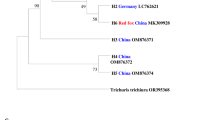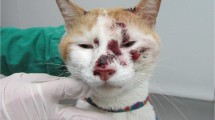Abstract
Toxocariasis is a helminthic zoonosis caused by larval stages of the roundworm of dog, Toxocara canis, and less frequently by T. cati, the roundworm of cats. Eosinophilia in peripheral blood may be indicative of a disease; however, it does not necessarily represent toxocariasis. Therefore, it is necessary to investigate the relationship between eosinophilia and toxocariasis in a region. The aims of this study were the diagnosis of hyperosinophilia patients using traditional ELISA kit and also by a handmade ELISA kit produced by T. canis excretory-secretory (TCES) antigens as well as the determination of the abundance of anti-Toxocara antibodies among people referred to Urmia, northwest of Iran care centers. Traditional ELISA kit was used to determine anti-TCES-specific IgG antibodies on 180 hypereosinophilic samples. These antibodies were evaluated in 1002 samples, including 180 hypereosinophilic samples and 822 random samples without eosinophilia by a handmade ELISA kit produced by TCES antigens. A Western-blot confirmatory test was performed on ELISA-positive samples. Our results showed a 17.22% prevalence rate of Toxocara antibodies among hypereosinophilic samples with traditional ELISA kit, and this rate was 3.89% in the 1002 study population with random sampling (with or without eosinophilia). Also, there was a good match between the results of handmade ELISA with those of traditional kit. The positive results in the ELISA method were confirmed by the Western-blot analysis. Our findings show that although the high eosinophil count is not necessarily a sign of toxocariasis, in Urmia distric, about one-fifth of eosinophilia cases have anti-toxocariasis antibodies. In addition, the abundance of anti-Toxocara antibodies in this area was 3.89%.
Similar content being viewed by others
References
Abdi J, Darabi M, Sayehmiri KJPJBS (2012) Epidemiological situation of toxocariasis in Iran: meta-analysis and systematic review. Pak J Biol Sci 15:1052–1055
Bae KW, Ahn SJ, Park KH, SJJKJoO Woo (2016) Diagnostic value of the serum anti-toxocara IgG titer for ocular toxocariasis in patients with uveitis at a tertiary hospital in Korea. Korean J Ophthalmol 30:258–264
Campos Júnior D, Elefant GR, Silva EODM, Gandolfi L, Jacob CMA, Tofeti A, Pratesi R (2003) Frequency of seropositivity to Toxocara canis in children of different socioeconomic strata. Revista da Sociedade Brasileira de Medicina Tropical 36:509–513
Despommier D (2003) Toxocariasis: clinical aspects, epidemiology, medical ecology, and molecular aspects. Clini Microbiol Rev 16:265–272
EbrahimiFard SF, Fakhar M, Sharif M, Shirvani N, Davood S (2015) Seroprevalence of Toxocara infection among adult individuals with eosinophilia in Babol, 2013. J Mazandaran Univ Med Sci 24(121):355–362
Farmer A, Beltran T, Choi YS (2017) Prevalence of Toxocara species infection in the US: Results from the National Health and Nutrition Examination Survey, 2011–2014. PLoS Negl Trop Dis 11(7):e0005818
Fialho PMM, Corrêa CRS (2016) A systematic review of toxocariasis: a neglected but high-prevalence disease in Brazil. The Am J Trop Med Hyg 94(6):1193–1199
Fillaux J, Santillan G, Magnaval JF, Jensen O, Larrieu E, Sobrino-Becaria CD (2007) Epidemiology of toxocariasis in a steppe environment: the Patagonia study. The Am J Trop Med Hyg 76(6):1144–1147
Fisher M (2003) Toxocara cati: an underestimated zoonotic agent. Trends Parasitol 19(4):167–170
Fu C-J et al (2014) Seroepidemiology of Toxocara canis infection among primary schoolchildren in the capital area of the Republic of the Marshall Islands. BMC Infect Dis 14(1):261
Iddawela D, Ehambaram K, Bandara P (2017) Prevalence of Toxocara antibodies among patients clinically suspected to have ocular toxocariasis: A retrospective descriptive study in Sri Lanka. BMC Ophthalmol 17(1):50
Jimenez J, Valladares B, Fernandez-Palacios J, De Armas F, Del Castillo A (1997) A serologic study of human toxocariasis in the Canary Islands (Spain): environmental influences. Am J Trop Med Hyg 56(1):113–115
Karadam SY, Ertug S, Ertabaklar H, Okyay P (2008) The comparision of IgG antibodies specific to Toxocara spp. among eosinophilic and non-eosinophilic groups. Microbiol-Q J Microbiol Sci 31(1):113–116
Kim HS et al (2014) Significance of serum antibody test for toxocariasis in healthy healthcare examinees with eosinophilia in Seoul and Gyeongsangnam-do, Korea. J Korean Med Sci 29:1618–1625
Kwon SI, Lee JP, Park SP, Lee EK, Huh S, Park IW (2011) Ocular toxocariasis in Korea. Jpn J Ophthalmol 55:143–147
Kwon JW, Sim Y, Jee D (2017) Association between intermediate uveitis and toxocariasis in the Korean population. Medicine (Baltimore) 96(5):e5829
Kyei G, Ayi I, Boampong J, Turkson PK (2015) Sero-epidemiology of Toxocara canis infection in children attending four selected health facilities in the central region of Ghana. Ghana Med J 49:77–83
Mattos GT, dos Santos PC, de Lima Telmo P, Berne MEA, Scaini CJ (2016) Human toxocariasis: Prevalence and factors associated with biosafety in research laboratories. The Am J Trop Med Hyg 95(6):1428–1431
Mazur-Melewska Katarzyna, Jonczyk-Potoczna Katarzyna, Kemnitz Paweł, Mania Anna, Figlerowicz Magdalena, Służewski Wojciech (2015) Pulmonary presentation of Toxocara sp. infection in children. Adv Respir Med 83(4):250–255
Merdin A, Ogur E, Kolak ÇÇ, Merdin FA (2016) A rare cause of hypereosinophilia: a case report. Türkiye Parazitolojii Dergisi 40:114
Pawlowski Z (2001) Toxocariasis in humans: clinical expression and treatment dilemma. J Helminthol 75:299–305
Regis SCS, Mendonça LR, dos Santos Silva N, Dattoli VCC, Alcântara-Neves NM, Barrouin-Melo SMJAT (2011) Seroprevalence and risk factors for canine toxocariasis by detection of specific IgG as a marker of infection in dogs from Salvador, Brazil. Acta Tropica 120:46–51
Van Den Broucke S et al (2015) Toxocariasis diagnosed in international travelers at the Institute of Tropical Medicine, Antwerp, Belgium, from 2000 to 2013. PLoS Negl Trop Dis 9:e0003559
Won EJ, Kim J, Shin M-G, Shin JH, Suh SP, Ryang DWJA (2015) Seroepidemiology of toxocariasis and its clinical implications in Gwangju and Jeonnam-province, Korea. Ann Lab Med 35:449–453
Woodhall DM, Fiore AE (2013) Toxocariasis: a review for pediatricians. J Pediatr Infect Dis Soc 3(2):154–159
Acknowledgements
The authors wish to thank the financial support of this study by Urmia University of Medical Sciences, Urmia, Iran (1395-01-43-2603).
Author information
Authors and Affiliations
Contributions
Simin Ashtari and Esmaeil Abasi prepared the proposal, collected samples and did the laboratory workup, Shahram Khademvatan helped with laboratory techniques such as Western blotting and Arash Aminpour designed the work, analyzed the data and prepared the manuscript.
Corresponding author
Ethics declarations
Conflict of interest
Authors declare that we have no conflict of interest.
Ethical issues
The study was approved by the Ethics Committee of Urmia University of Medical Sciences, Urmia, Iran (approval number: 1395-01-43-2603).
Additional information
Publisher's Note
Springer Nature remains neutral with regard to jurisdictional claims in published maps and institutional affiliations.
Rights and permissions
About this article
Cite this article
Ashtari, S., Khademvatan, S., Abasi, E. et al. Designing and standardizing Toxocara serologic diagnostic kit and determining anti-Toxocara antibodies frequency in patients referred to health care centers in Urmia (northwest of Iran). J Parasit Dis 43, 270–275 (2019). https://doi.org/10.1007/s12639-019-01088-5
Received:
Accepted:
Published:
Issue Date:
DOI: https://doi.org/10.1007/s12639-019-01088-5




